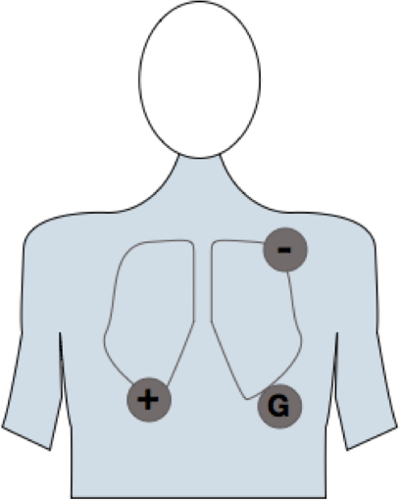Correlatos fisiológicos de reconocimiento de la emoción
Visión general
Fuente: Laboratorios de Jonas T. Kaplan y Sarah I. Gimbel, University of Southern California
Sistema nervioso autónomo (ANS) controla la actividad de los órganos internos del cuerpo y regula cambios en su actividad dependiendo del entorno actual. El nervio vago que inerva muchos de los órganos internos, es una parte importante del sistema. Cuando nuestro cerebro detecta peligro, tono vagal se inhibe, a un conjunto de cambios en el cuerpo diseñado para hacernos más preparado para luchar o huir; por ejemplo, aumenta el ritmo cardiaco, nuestras pupilas se dilatan y respirar más rápidamente. Por el contrario, cuando se activa el sistema vagal, estas respuestas fisiológicas son inhibidas, llevando a un estado más tranquilo. El nervio vago, entonces, actúa como una especie de "freno" en nuestro despertar. Una consecuencia interesante de este estado más tranquilo es que tiende a promover la interacción social-cuando nosotros no estamos tenso y miedo de nuestro entorno inmediato son receptivos a interactuar con otras personas. Mal funcionamiento de este mecanismo de regulación, por lo tanto, puede asociarse con dificultades en el comportamiento social.
Un índice de regulación autonómica es la variabilidad del ritmo cardíaco (HRV). HRV es una medida de cuánto la brecha entre un latido y el siguiente varía con el tiempo. HRV alta significa que hay continuas fluctuaciones en la frecuencia cardiaca con el tiempo, un reflejo de la exitosa regulación autonómica. VFC bajo significa que hay consistencia de la frecuencia cardiaca con el tiempo, una condición asociada a la pobre regulación autonómica.
En este estudio que vamos a probar la hipótesis de que el aumento de HRV se asocia con una clasificación más precisa de estímulos emocionales. 1, 2 por un estudio de Park et al., vamos a medir HRV y probar su asociación en una tarea que mide la habilidad para percibir emociones faciales. 3
Procedimiento
1. reclutar a 40 participantes.
- Los participantes deben tener visión normal o corregida a normal para asegurar que será capaces de ver correctamente a los estímulos.
- Los participantes no deben consumir alcohol, cafeína u otras drogas para por lo menos 6 horas antes del experimento.
- Los participantes deben no tienen antecedentes de trastornos neurológicos, psiquiátricos o cardiacos.
2. pre-experimento procedimientos
Resultados
Rendimiento en la tarea de reconocimiento facial de la emoción es típicamente muy alto; en nuestros datos precisión fue 92.5%. Los participantes fueron más precisos en la identificación de neutro caras (94,1%) en comparación con rostros temerosos (90.9%). Lo importante, poder HRV alta frecuencia correlacionaron significativamente con exactitud en la identificación de caras temerosas ()figura 2). Individuos con alta HRV fueron más precisos en la id...
Aplicación y resumen
Este experimento demuestra el poder de datos fisiológicos para proporcionar la penetración en la cognición humana. El hallazgo de que las medidas del corazón pueden utilizarse para entender el funcionamiento psicológico nos recuerda de la íntima conexión entre el cerebro y el cuerpo. Un índice de saludable control cognitivo y regulación de la emoción, variabilidad del ritmo cardíaco puede servir como un biomarcador relativamente no invasiva para la salud mental. Por ejemplo, HRV baja se asocia con trastornos d...
Referencias
- Appelhans, B.M. & Luecken, L.J. Heart rate variability as an index of regulated emotional responding. Rev Gen Psychol 10, 229-240 (2006).
- Thayer, J.F. & Lane, R.D. A model of neurovisceral integration in emotion regulation and dysregulation. J Affect Disord 61, 201-216 (2000).
- Park, G., Van Bavel, J.J., Vasey, M.W., Egan, E.J. & Thayer, J.F. From the heart to the mind's eye: cardiac vagal tone is related to visual perception of fearful faces at high spatial frequency. Biol Psychol 90, 171-178 (2012).
- Chalmers, J.A., Quintana, D.S., Abbott, M.J. & Kemp, A.H. Anxiety Disorders are Associated with Reduced Heart Rate Variability: A Meta-Analysis. Front Psychiatry 5, 80 (2014).
- Kemp, A.H., et al. Impact of depression and antidepressant treatment on heart rate variability: a review and meta-analysis. Biol Psychiatry 67, 1067-1074 (2010).
- Gillie, B.L. & Thayer, J.F. Individual differences in resting heart rate variability and cognitive control in posttraumatic stress disorder. Front Psychol 5, 758 (2014).
Saltar a...
Vídeos de esta colección:

Now Playing
Correlatos fisiológicos de reconocimiento de la emoción
Neuropsychology
16.2K Vistas

El cerebro dividido
Neuropsychology
68.3K Vistas

Mapas de motor
Neuropsychology
27.5K Vistas

Perspectivas de la neuropsicología
Neuropsychology
12.0K Vistas

Toma de decisiones y la Iowa Gambling Task
Neuropsychology
32.5K Vistas

Función ejecutiva en el trastorno del espectro autista
Neuropsychology
17.7K Vistas

Amnesia Anterógrada
Neuropsychology
30.3K Vistas

Potenciales acontecimiento-relacionados y la tarea de Oddball
Neuropsychology
27.5K Vistas

Idioma: La N400 en incongruencia semántica
Neuropsychology
19.6K Vistas

Aprendizaje y la memoria: la tarea de recordar-sabe
Neuropsychology
17.1K Vistas

Medición de las diferencias de materia gris con Morfometría basada en Voxel: el cerebro Musical
Neuropsychology
17.3K Vistas

Descodificación de imágenes auditivas con análisis Multivoxel
Neuropsychology
6.4K Vistas

Atención visual: fMRI Control atencional basado en la investigación del objeto
Neuropsychology
41.8K Vistas

Utilizando imágenes de Tensor de difusión en la lesión cerebral traumática
Neuropsychology
16.7K Vistas

Uso de TMS para medir la excitabilidad motora durante la observación de la acción
Neuropsychology
10.1K Vistas
ACERCA DE JoVE
Copyright © 2025 MyJoVE Corporation. Todos los derechos reservados
